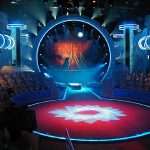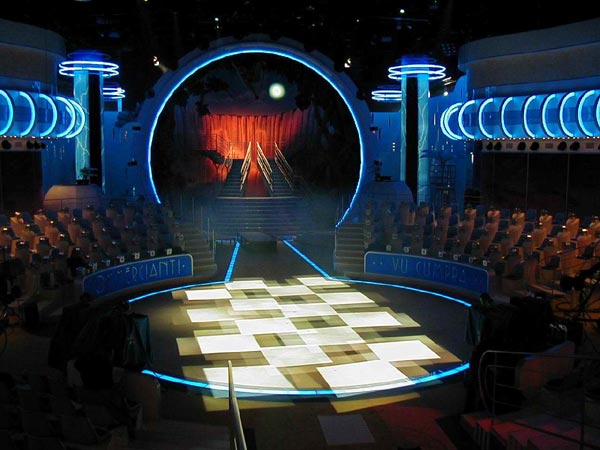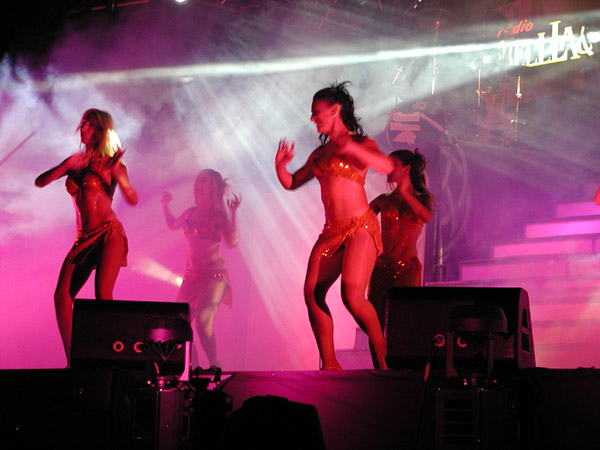After 4 years of TV success, this edition of Ciao Darwin stretched the imagination to the limit: Mediaset’s Studio 20 in Cologno Monzese was designed to reflect the fantastical character of this program, where everything – protagonists, games and “journeys through time” – was over the top. The studio consisted of a central stage for contestants, whereas behind the proscenium a double staircase emerged from a surreal landscape, where the evening’s protagonists descended. It took several months to design this elaborate and imaginative set, which was crafted down to the finest detail for maximum impact.
We visited Ciao Darwin’s set during rehearsals and talked to photography director, Franco Fratus, who was clearly one of the chief engineers behind this undertaking.
How did you come up with the idea for this set of “Ciao Darwin”?
We wanted to reflect the slightly extravagant and typically light-hearted nature of this program, so we designed the set ad hoc, making it imposing and fun at the same time. During design, I met up with director Beppe Recchia and set designer Claudio Brigatti to plan the basic idea. It is important to remember that we were working on a TV show, so all the lighting, projection angles and props depended on filming requirements. This all had to be defined before putting up the set.
What is the link between lighting and set design?
The first thing to consider is how to fit the lighting system supporting structures into the actual scenery. All the trusses and battens should be concealed as much as possible. For example, we have hidden the projectors behind a round proscenium, which seems part of the scenery: this circular theme is echoed in the auditorium and on the battens holding the projectors. There is also another set outside the studio for the “journey through time” game: in this case, the scenery varies each time.
And the link with filming?
You always have to imagine the effect it’ll have on the TV screen, as it depends on the filming methods and angles. Ciao Darwin is screened in a large area, so there are more filming angles to choose from and Paolo Bonolis moves constantly from one side of the studio to the other. It’s important to bear in mind the various positions for the lights before installing them in order to meet all the filming requirements. You also need experience and intuition to imagine the final effect through the eyes of the camera. It’s a problem when you realize that the lights look great in the studio, but not on television!
How come you chose Clay Paky’s new moving body beam shapers, Stage Profile Plus SV, and what do you think of their performance?
I specifically asked for the “Profile Plus” models for my lighting design because they seemed to be the only ones that offered something really innovative. I left it all up to Renato Neri’s Xenon, which supplied all the necessary material in good time, with its impeccable service and expertise.
These products are fantastic because they can create geometric shapes and images that I’ve never seen before, as well as composing and decomposing them in every possible way. The new intelligent “beam shaper” has brought a new concept of imagery into professional lighting. Now lighting designers have an unprecedented range of graphic compositions at their fingertips. Clay Paky’s Stage Profile Plus SV is certainly the most advanced, complete, accurate and versatile beam shaper on the market.
We then talk to Andrea Mantovani, Lighting Designer and lighting operator for Ciao Darwin, and Doriano Frenda, technical manager of Xenon, which supplied the entire sound and lighting system.
What is the link between a lighting design and the photography director’s job?
The photography director takes care of the image within its setting, comes up with the idea for a lighting design and gives us the general guidelines.
The Lighting Designer and his assistants then work out how to realize the design in the best possible way.
We have heard about all the various problems TV show lighting. Could you go into more detail?
The image is not designed for people in the studio, but only for broadcasting, so everything is planned for the result on TV. The difficulty lies in creating a lighting design for the television, which involves electronics, so there are some colours and shapes that the camera is not able to read. For example, gobo designs and filming positions have to be studied each time. So you always have to bear in mind what you can see on the screen. Unlike live shows, there are more filming angles to consider: one can be from the front, another from the side. You have to make a careful choice and study every single detail so that the camera can “see” it in the best possible way. To give you an example, the TV camera tends to “squash” gobo angles on the projection surface.
Could you show us what lights you have used and the features of the projectors?
16 Stage Profile Plus SVs are fitted on the 8-metre diameter batten overhead. These play an important role, as they give the show movement with multi-shaped graphic projections, which come to life during launches and after adverts.
The proscenium has 15 Stage Zoom 1200s (on the inside) and 14 Mini Scan HPEs (on the outside).
Some Stage Zoom 1200s and Stage Color 1200s are fitted on the circular batten which is 4 metres in diameter, and 16 Stage Light 300s are on the opposite proscenium, with another 6 Stage Zooms for backlighting.
What kind of lighting products do TV lighting designers prefer to use?
Powered spotlights are used more and more now in TV studios because they are so versatile. They can direct light onto protagonists or move and create sidelighting or backlighting. The moving body covers every single angle of the studio, which simplifies our job a lot. We usually create two different lighting conditions to illuminate the set. One involves white light, which allows you to “see” and illuminate people, objects and scenery, which is why we still prefer to use halogen lamps. The other type of lighting creates effects that liven up the set and accompany music: this is typical at the end of a show. This edition of Ciao Darwin features the spectacular lighting effects created by Stage Profile Plus.
Why are Clay Paky products used so often in sets that Xenon installs for TV and live shows?
”Xenon has been using Clay Paky products for years now,” reveals Doriano Frenda, “because they are totally reliable in any occasion, as well as being extremely versatile and resistant to prolonged use. They also have incredibly powerful luminosity and exceptional optics. Since 2002, new Stage Profile Plus has opened up new horizons in professional and show lighting. We thought it would be ideal for a program like Ciao Darwin. And from the looks of it, we were right”.
Lighting system specifications:
16 Stage Profile Plus SVs
27 Stage Zoom 1200s
6 Stage Color 1200s
16 Stage Light 300s
14 Mini Scan HPEs
Console: 2 spark 4d















